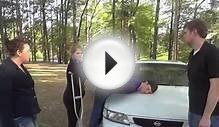
For 16 years, "mad bomber" George Metesky eluded New York City police. Metesky planted more than 30 small bombs around the city between 1940 and 1956, hitting movie theaters, phone booths and other public areas.
In 1956, the frustrated investigators asked psychiatrist James Brussel, New York State's assistant commissioner of mental hygiene, to study crime scene photos and notes from the bomber. Brussel came up with a detailed description of the suspect: He would be unmarried, foreign, self-educated, in his 50s, living in Connecticut, paranoid and with a vendetta against Con Edison-the first bomb had targeted the power company's 67th street headquarters.
While some of Brussel's predictions were simply common sense, others were based on psychological ideas. For instance, he said that because paranoia tends to peak around age 35, the bomber, 16 years after his first bomb, would now be in his 50s. The profile proved dead on: It led police right to Metesky, who was arrested in January 1957 and confessed immediately.
In the following decades, police in New York and elsewhere continued to consult psychologists and psychiatrists to develop profiles of particularly difficult-to-catch offenders. At the same time, though, much of the criminal profiling field developed within the law enforcement community-particularly the FBI.
Nowadays profiling rests, sometimes uneasily, somewhere between law enforcement and psychology. As a science, it is still a relatively new field with few set boundaries or definitions. Its practitioners don't always agree on methodology or even terminology. The term "profiling" has caught on among the general public, largely due to movies like "The Silence of the Lambs" and TV shows like "Profiler." But the FBI calls its form of profiling "criminal investigative analysis"; one prominent forensic psychologist calls his work "investigative psychology"; and another calls his "crime action profiling."
Despite the different names, all of these tactics share a common goal: to help investigators examine evidence from crime scenes and victim and witness reports to develop an offender description. The description can include psychological variables such as personality traits, psychopathologies and behavior patterns, as well as demographic variables such as age, race or geographic location. Investigators might use profiling to narrow down a field of suspects or figure out how to interrogate a suspect already in custody.
"In some ways, [profiling] is really still as much an art as a science, " says psychologist Harvey Schlossberg, PhD, former director of psychological services for the New York Police Department. But in recent years, many psychologists-together with criminologists and law enforcement officials-have begun using psychology's statistical and research methods to bring more science into the art.
How does profiling work?
Informal criminal profiling has a long history. It was used as early as the 1880s, when two physicians, George Phillips and Thomas Bond, used crime scene clues to make predictions about British serial murderer Jack the Ripper's personality.
At the same time, profiling has taken root in the United States, where, until recent decades, profilers relied mostly on their own intuition and informal studies. Schlossberg, who developed profiles of many criminals, including David Berkowitz-New York City's "Son of Sam"-describes the approach he used in the late 1960s and 70s: "What I would do, " he says, "is sit down and look through cases where the criminals had been arrested. I listed how old [the perpetrators] were, whether they were male or female, their level of education. Did they come from broken families? Did they have school behavioral problems? I listed as many factors as I could come up with, and then I added them up to see which were the most common."
In 1974, the FBI formed its Behavioral Science Unit to investigate serial rape and homicide cases. From 1976 to 1979, several FBI agents-most famously John Douglas and Robert Ressler-interviewed 36 serial murderers to develop theories and categories of different types of offenders.
Most notably, they developed the idea of the "organized/disorganized dichotomy": Organized crimes are premeditated and carefully planned, so little evidence is found at the scene. Organized criminals, according to the classification scheme, are antisocial but know right from wrong, are not insane and show no remorse. Disorganized crimes, in contrast, are not planned, and criminals leave such evidence as fingerprints and blood. Disorganized criminals may be young, under the influence of alcohol or drugs, or mentally ill.
Over the past quarter-century, the Behavioral Science Unit has further developed the FBI's profiling process-including refining the organized/disorganized dichotomy into a continuum and developing other classification schemes.
Share this Post
INTERESTING PSYCHOLOGY VIDEO












